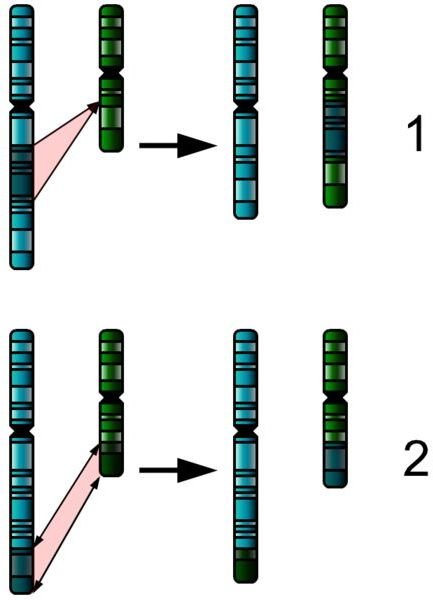The Causes of Chromosomes Mutation
The causes of chromosomes mutation occur when there is any change in the arrangement or structure of the chromosomes. These mutations occur most often during meiosis during the stage when crossing over occurs. There are several different mutation types that result in chromosomal structure change. This change in structure leads to serious changes in an organisms’ phenotype and genotype. If essential parts of the DNA are affected by chromosomal mutations, a foetus can be aborted prior to birth without the mother’s control. Mutations are either acquired or inherited from a parent.
Translocations
This cause of mutation occurs when a piece of one chromosome is transferred to a non-homologous chromosome. The two chromosomes, that are often reciprocal, swap segments with each other. This genetic mutation is often responsible for chronic myelogenous leukemia. This is because Philadelphia chromosome, a chromosomal abnormality, being shared with leukemic cells. A reciprocal translocation between the 9 and 22 chromosomes cause this abnormality due to the creation of an abnormal hybrid gene. This hybrid gene leads to a novel protein, not found in normal cells, being produced. When it is produced, normal development and growth are prevented, resulting in leukemia.
Inversion
One of the causes of chromosomes mutation is inversion. This occurs when an area of DNA on a chromosome flips its orientation with regard to the remainder of the chromosome. If chromosome 16 is affected by just one inversion it can cause leukemia. If inversion leads to an embryo having too few or too many copies of genes, the embryo can miscarry, fail to grow, or be born alive with substantial medical problems.
Deletions
With this cause of mutation, a decrease in the number of genes occurs due to the deletion of a large section of a chromosome. Deletion can result in a variety of genetic disorders, such as Prader-Willi syndrome, Cri d Chat syndrome, and Angelman’s syndrome.
Duplications
When genes are duplicated it results in them being displayed twice on a single chromosome. Having three copies of chromosome 16, known as trisomy 16, is the most common trisomy experienced by humans. If this comes in a mosaicism pattern, babies can be born and grow up with a variety of medical issues. These include poor fetal growth during pregnancy, unusual facial features, musculoskeletal anomalies, congenital heart defects, respiratory tract problems or underdeveloped lungs, and urethral opening too low.
Chromosome Non-Disjunction
When chromosomes do not separate successfully to opposite poles, during cell division, this results in one of the daughter cells lacking a chromosome and the other having an extra chromosome. If a human egg cells’ chromosome 21 is affected by non-disjunction, Downs syndrome results. Those with this condition will have 47 chromosome in every cell as opposed to 46 like normal. Downs syndrome is characterized by mental retardation, heart defects, and stunted growth.
Resources
European Bioinformatics Institute. (2010). Types of Mutations. Retrieved on February 28, 2010 from the European Bioinformatics Institute: https://www.ebi.ac.uk/2can/disease/genes5.html#chromosomal
University of Utah Genetic Disorders Library. (2010). What Are Genetic Disorders? Retrieved on February 28, 2010 from the University of Utah Genetic Disorders Library: https://learn.genetics.utah.edu/content/disorders/whataregd/
Image Credits
Chromosomal Mutation: Translocation: Zephyris – Wikimedia Commons
